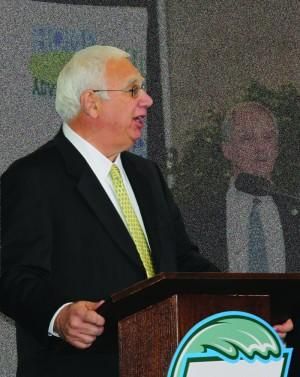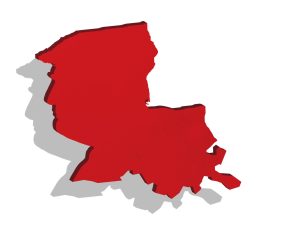No headline provided

March 22, 2012
John Scimeca: Can you give us an update on the progress being made toward an on-campus stadium?
Scott Cowen: We’re starting the planning process in earnest right now because we have a targeted date to open the stadium up in the fall of 2014. So to make that date – which is pretty ambitious because we’re only two-and-a-half years away – we have to start full-bore right now, and we’re doing that. We’re working with the architects. We’re assembling a project management team that would manage the entire project from soup to nuts, so things are moving very quickly.
JS: If the athletic department fails to raise enough money by September, will the construction of the stadium be delayed?
SC: We anticipate the money will be raised. We’re off to a very good start. The goal is to raise $60 million. We’ve raised about $42 million already, and we believe we’ll be able to raise the rest. We’re planning as if that’s going to open up in 2014.
JS: You played a leading role in the recent Conference USA-Mountain West Conference merger. Is there a contingency plan if more schools leave either conference?
SC: I’ll give you a thorough update on that. I actually chair the Conference USA board, and the board is made up of presidents of all the members of Conference USA. The president of UNLV chairs the board for the Mountain West. So we have 16 schools that will be in the new conference, and we’re working very closely together – and very successfully, I might add – to work to create this new association between the two entities. As a matter of fact, we have created the formation agreements to form this new entity, and we have groups in place that are working on the TV contracts. There’s a possibility of adding new members over the 16 schools. We’re working on where we’ll headquarter the new association, what will be the management of the new association, and we’re working on marketing and branding of the new association. So our belief is that it’s going to happen. The contingency plan is that we would just stay in Conference USA and add new members. But I think there’s a very high probability that the new association will be formed with at least 16 schools in it, and there is the possibility that we could go up to 24 schools.
Ryan Jones: In 2010, you said that conference realignment is just like “changing deck chairs on the Titanic.” But in your interview with Sports Illustrated, you talk about how there may only be 65 relevant Division I teams within a decade. That seems to suggest that your views on conference realignment have evolved to an extent.
SC: Well, I still believe that the notion of what’s happening in intercollegiate athletics is still a very unfortunate situation, and there’s still big issues that are going to confront the schools in the FBS over time. I still believe that there are systemic issues in the FBS division, and it’s not sustainable. That’s what I mean by rearranging the deck chairs. I stick by that. But in the meantime, we have to continue on with life, and the feeling is that if we’re in a more stable conference – and a larger conference, quite honestly, that will reach from Hawaii to the East Coast – we’re likely to play a much stronger presence in the FBS than we do in Conference USA. What we’re looking for is stability and long-term growth potential of the conference in terms of TV and revenue, so I think this vehicle we’re exploring has the promise to deliver that.
JS: When you became president at Tulane, you probably didn’t think you’d be spending this much time on athletics. When you look back at what you’ve accomplished at Tulane, do you think athletics is a missing gap – something that you still want to improve?
SC: We’ve actually made a lot more progress than people give us credit for. Just think for a moment and look at our facilities. We have a new baseball stadium that we built in the last six years. We have a new volleyball and basketball practice facility. We’re going to be building a new stadium. We’re going to be doing a significant renovation of Fogelman Arena for our basketball team. So if you look at it in terms of facilities, we’ve had a significant enhancement, more so than in any other decade of the university, quite honestly.
Where we have been disappointed is the performance of our football teams and our men’s basketball team. If you look at our other teams, look at the performance of our women’s basketball team. They’re great. If you look at the tennis teams and the Olympic sports, they’re doing well. So don’t say the whole thing is a failure. It’s clearly not a failure.
What we’re disappointed in is men’s football. And the issue with our football team is not new with my presidency. If you go back over the last 60 years of Tulane football, we’ve only had about two-and-a-half winning seasons per decade, so this is not a new problem. What we’re trying to do is find solutions that are sustainable. What we don’t want to do is what happened in the late ’90s when I came, where we had two years where we were great. We were 7-4, we went undefeated, and then we went off the ledge again. And then there would be 10 more years of not-good teams. What we’re trying to do is to build a sustainable program in men’s basketball and in football so that they’re good every year. You do that with facilities, coaches, and the infrastructure for support and academic advising for the student athletes. We’re doing all that.
We weren’t able to do that after [Hurricane Katrina]. I don’t think people appreciate how few resources we had. And the resources we did have, we put into the academic enterprise to make sure we could rebuild that. Otherwise, you guys wouldn’t have come here. One of the attractions is that we’re a pretty good academic institution. We’re a very good academic institution. We’re better, and now we’re looking for a permanent fix. I’m one that’s always looking for permanent fixes – not a Band-Aid for a year or two. It took us a while to get to the point where we had the resources to put into place a permanent for football and men’s basketball, and we’re on the way to doing that.
RJ: When you haven’t had success for a while, fans tend to want to push the blame somewhere or at a certain person. If football head coach Curtis Johnson doesn’t succeed, at what point do you have to start pointing at the athletic director?
SC: Whenever you’re not successful, there’s shared blame. There’s not one person. We all can take blame. I can take blame in it, the athletic director, the coaches and so on. But when you’re building a program, especially when you’re starting at a fundamental level, it takes about five years. Rarely do you see someone come in and turn around a program in a year or two. So our view in football is that it clearly takes about five years because of the recruiting cycles. Basketball you can do a little bit faster – in two or three years – but football takes longer. So what you look for is where we’ll be in football five years from now with the expectation that we make progress every year. We don’t want to make it a hockey stick where we’re bad for four years and then all of a sudden we’re wonderful and everybody thinks we’ve solved it. What we want to see is progression every single year. We want to see that in men’s basketball as well. But five years, I think, is the right time frame to judge these things.
RJ: Do you think that Tulane would be a good fit in a power conference like the Big East or the Big XII or not?
SC: I think there are certain power conferences where we would be a very good fit. If you look at the ACC, they have academic institutions that are very comparable to us, Wake Forest and so on. So I think if you’re looking at an overall fit from an academic and an athletic point of view, I think the ACC and I certainly think the Big 12 fits, given their proximity and some of the institutions that they have. If you look at the Big East now, the Big East is no more than the old Conference USA.
Every school in the Big East with the exception of Rutgers and UConn will have come from Conference USA and the Mountain West. My view is that the Big East is not a power conference, and anyone who thinks they are doesn’t know athletics. The power conferences now are the Big 12, the Pac-12, the ACC, the Big Ten and the SEC. The other thing I’ve seen is that the parity is getting much better even between the power conferences and all the rest. When I was fighting the fight back in 2003 around the BCS, the Boise States, the TCUs, the Utahs were never thought of in the same breath as the power conferences. Now, they’re all joining the power conferences because they’ve proved their way in football.
Now, having said that, I think there’s a high probability that the BCS and automatic qualifiers are going to go away anyway in two years. We pointed that out in 2003. We fought the battle to get the BCS changed, and it was changed. We advocated back then that it was bad for intercollegiate athletics, and I still think it was very bad for intercollegiate athletics. I think in the next round of athletics, it’s going to go away.









Leave a Comment